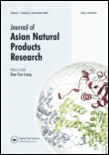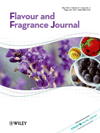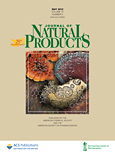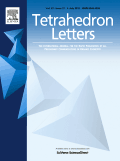
Journal of Essential Oil Bearing Plants
Scope & Guideline
Advancing Knowledge in Essential Oils
Introduction
Aims and Scopes
- Chemical Composition Analysis:
The journal publishes studies that analyze the chemical constituents of essential oils using various methods such as GC-MS, providing insights into their composition and variability across different species and environments. - Biological Activities:
Research focuses on the biological activities of essential oils, including antimicrobial, antioxidant, anti-inflammatory, and anticancer properties, contributing to the understanding of their therapeutic potential. - Phytochemical Investigations:
The journal encourages studies that explore the phytochemical profiles of essential oils, linking specific compounds to their biological effects, and enhancing the understanding of their efficacy. - Agronomic and Environmental Studies:
There is a significant emphasis on how environmental factors and agricultural practices influence the yield and quality of essential oils, promoting sustainable cultivation methods. - Innovative Extraction Techniques:
Research on novel extraction methods, including microwave-assisted extraction and nanoencapsulation, is prevalent, showcasing advancements in enhancing oil yield and quality. - Applications in Food and Medicine:
The journal emphasizes the application of essential oils in food preservation, pharmaceuticals, and natural remedies, highlighting their importance in various industries.
Trending and Emerging
- Machine Learning Applications:
The integration of machine learning techniques to predict and analyze the chemical components of essential oils is gaining traction, indicating a shift towards data-driven methodologies in research. - Nanotechnology and Encapsulation:
Research into the use of nanotechnology for encapsulating essential oils for enhanced delivery and stability is emerging, showcasing innovative applications in pharmaceuticals and food preservation. - Environmental Impact Studies:
There is a growing trend in assessing the environmental impacts on essential oil yield and composition, reflecting an increasing awareness of sustainability in agricultural practices. - In Silico Studies:
The incorporation of in silico methods for predicting biological activities and interactions of essential oils is emerging, complementing traditional experimental approaches. - Synergistic Effects and Formulations:
Research exploring the synergistic effects of essential oils in combination with other compounds or in formulations is on the rise, indicating an interest in developing more effective applications. - Focus on Endemic and Native Species:
Emerging studies are increasingly focusing on the essential oils of endemic and native species, highlighting their unique properties and potential applications in local contexts.
Declining or Waning
- Traditional Uses of Essential Oils:
Studies focusing solely on the traditional uses of essential oils without scientific validation or modern applications have seen a decline, as the journal increasingly emphasizes empirical research and innovative applications. - Basic Descriptive Studies:
There has been a noticeable reduction in purely descriptive studies that do not explore the biological or practical significance of essential oils, as the journal trends towards more applied research. - Historical and Cultural Contexts:
Research exploring the historical or cultural contexts of essential oils without a strong scientific or practical component is becoming less common, as the focus shifts towards empirical and actionable findings.
Similar Journals

PHYTOCHEMISTRY REVIEWS
Fostering Excellence in Phytochemical ResearchPhytochemistry Reviews is an esteemed journal published by Springer, proudly positioned within the top tier of its fields. With an impressive impact factor and recognized as Q1 in both Biotechnology and Plant Science, it serves as a vital resource for scholars and practitioners alike. The journal provides in-depth reviews centered around the chemistry of plant-based compounds, their biological activities, and applications in various industries, thus encompassing a rich inter-disciplinary approach that bridges several areas of scientific inquiry. Since its inception in 2002, Phytochemistry Reviews has become a cornerstone for innovative research, offering comprehensive insights that foster advancements within agricultural, biochemical, and biotechnological realms. Although it is not an open-access publication, the journal remains an essential platform for disseminating high-impact findings, ensuring that professionals, educators, and emerging researchers have access to cutting-edge knowledge that propels the field forward. For those engaged in the ever-evolving world of phytochemistry and related disciplines, Phytochemistry Reviews is a must-read, embodying excellence and scholarly rigor.

JOURNAL OF ASIAN NATURAL PRODUCTS RESEARCH
Bridging Cultures Through Natural Product ResearchJOURNAL OF ASIAN NATURAL PRODUCTS RESEARCH is a prestigious publication in the field of natural products, focusing on valuable research spanning analytical chemistry, pharmacology, and complementary medicine. Published by Taylor & Francis Ltd in the United Kingdom, this journal has established itself as a key resource for academics and professionals seeking to explore advancements in drug discovery and organic chemistry. With a converged publication timeline from 1998 to 2024, the journal boasts several commendable category quartiles as of 2023, reflecting its robust standing in the research community: Q2 in Complementary and Alternative Medicine, Q3 in multiple domains including Analytical Chemistry and Organic Chemistry, and Q4 in Molecular Medicine. Although it currently does not offer open access, the journal remains a valuable compendium for empirical research and innovative studies in areas such as pharmacology and medicinal chemistry. Researchers, professionals, and students alike will find the JOURNAL OF ASIAN NATURAL PRODUCTS RESEARCH to be an essential platform for sharing groundbreaking findings and fostering collaborations that lead to significant advancements in science and health.

Heterocyclic Letters
Pioneering Discoveries in Medicinal and Agricultural ChemistryHeterocyclic Letters is an esteemed journal in the field of synthetic organic chemistry, published by RAMAN PUBL. With ISSN 2231-3087 and E-ISSN 2230-9632, this journal aims to disseminate original research and innovative findings related to heterocyclic compounds, which play a crucial role in medicinal chemistry, material science, and agricultural chemistry. Heterocyclic Letters provides a platform for researchers, professionals, and students to share their insights and advancements, thus fostering academic collaboration and knowledge transfer. The journal is dedicated to maintaining high-quality standards in research publication, making it an essential resource for anyone focused on the latest developments in heterocyclic chemistry. Although it does not currently offer Open Access options, the journal’s rigorous peer-review process ensures that only the most credible and impactful studies are published, contributing significantly to the advancement of the field.

Annals of Phytomedicine-An International Journal
Pioneering Insights into Nature's RemediesAnnals of Phytomedicine - An International Journal is a leading publication dedicated to the exploration and advancement of phytomedicine, broadly encompassing research on medicinal plants, their bioactive compounds, and therapeutic applications. Published by UKAAZ Publications, this journal seeks to bridge the gap between traditional and modern medicinal practices, offering a platform for researchers, professionals, and students passionate about herbal therapies and their efficacy. With an ISSN 2393-9885 and E-ISSN 2278-9839, the journal adheres to stringent peer-review protocols to ensure the publication of high-quality research. Fostering open access to knowledge in a rapidly evolving field, Annals of Phytomedicine serves as an essential resource, promoting innovative findings and comprehensive reviews that drive the global discourse on phytotherapy. By engaging with this journal, readers can stay informed about the latest advancements, contributing significantly to the scholarly community and beyond.

Natural Products and Bioprospecting
Pioneering the Future of Natural Product ApplicationsNatural Products and Bioprospecting is a prestigious academic journal published by SPRINGERNATURE, dedicated to advancing research in the fields of analytical chemistry, biochemistry, plant science, organic chemistry, and pharmacology. With an impact factor that positions it within the top quartiles across multiple categories, this journal serves as a crucial platform for disseminating groundbreaking findings and innovative methodologies focusing on the potential of natural products. Since adopting its Open Access model in 2011, it has broadened its reach, allowing global accessibility to cutting-edge research. The journal, based in Singapore, aims to foster interdisciplinary collaboration and encourages submissions that explore the intricate relationships between natural products and their applications in food science, toxicology, and pharmacology. Its well-respected status is further highlighted by impressive Scopus ranks and a growing H-index, reinforcing its significance in the scientific community. Researchers, professionals, and students alike can benefit from the rich repository of knowledge that Natural Products and Bioprospecting continuously curates and disseminates, making it an invaluable resource in the quest for innovative solutions derived from nature.

FLAVOUR AND FRAGRANCE JOURNAL
Innovating Sensory Experiences Through ResearchThe FLAVOUR AND FRAGRANCE JOURNAL, published by WILEY, is a prestigious academic periodical dedicated to the interdisciplinary study of flavour and fragrance chemistry. With a commendable impact factor and ranked Q2 in both the Chemistry (miscellaneous) and Food Science categories, this journal plays a pivotal role in disseminating innovative research that enhances our understanding of sensorial experiences. Established in 1985, it continues to serve as a vital platform for scientists, industry professionals, and scholars who are engaged in the exploration of aromas and flavours, thereby fostering advancements in food science, sensory analysis, and product development. Although it is not an open-access journal, the high visibility and notable contributions reflect its significant standing in the academic community, encouraging discourse and collaboration among its readership. Researchers and students alike will find invaluable insights and cutting-edge studies that push the boundaries of flavour and fragrance research within its pages.

JOURNAL OF NATURAL PRODUCTS
Harnessing Nature's Wisdom for Modern ScienceJOURNAL OF NATURAL PRODUCTS, published by the American Chemical Society, is a premier academic journal that focuses on the study and application of natural products in various scientific domains. With an esteemed ISSN of 0163-3864 and an E-ISSN of 1520-6025, this journal caters to a wide range of fields, including Analytical Chemistry, Complementary and Alternative Medicine, Drug Discovery, Molecular Medicine, Organic Chemistry, Pharmaceutical Science, and Pharmacology. The journal consistently ranks in the Q1 and Q2 quartiles across these categories, reflecting its significant contribution and rigorous standards in the scientific community. Notably, its Scopus rankings highlight its influence, with notable percentiles across various fields, including a 93rd percentile in Complementary and Alternative Medicine. The JOURNAL OF NATURAL PRODUCTS aims to advance knowledge in the field by publishing groundbreaking research articles, reviews, and critical insights, making it an essential resource for researchers, professionals, and students dedicated to exploring the vast potential of natural substances. This journal addresses complex challenges and fosters innovative developments, further establishing its place as a cornerstone in natural products research. Access to published articles may vary, underscoring the need for individuals in this field to stay connected with the latest advances through the journal's offerings.

TETRAHEDRON LETTERS
Fostering Collaboration in the Chemical Sciences LandscapeTETRAHEDRON LETTERS, published by Pergamon-Elsevier Science Ltd, is a leading journal in the fields of Biochemistry, Drug Discovery, and Organic Chemistry, with a rich legacy since its inception in 1959. This prestigious journal serves as a vital resource for researchers and professionals dedicated to advancing the understanding of chemical sciences, featuring high-impact research that influences both academic and practical applications. Although it is currently classified in the third quartile across its categories for 2023, its rigorous peer-review process ensures the publication of quality research that contributes to the scientific community. With an ISSN of 0040-4039 and an E-ISSN of 1873-3581, TETRAHEDRON LETTERS is easily accessible for those in the academic landscape seeking to stay abreast of innovative developments. Researchers, professionals, and students alike will find invaluable insights and collaborative opportunities within the pages of TETRAHEDRON LETTERS, making it an essential read for anyone involved in the chemical sciences.

ACS Food Science & Technology
Exploring the Chemistry of Culinary InnovationACS Food Science & Technology is a premier peer-reviewed journal published by the American Chemical Society (ACS) that addresses the dynamic intersections of food science, chemistry, and technology. With its E-ISSN: 2692-1944, this journal aims to disseminate innovative research and comprehensive reviews that enhance understanding in fields such as analytical chemistry, organic chemistry, and general food science. Despite the absence of an Open Access model, its position in the Q2 quartile for multiple categories in 2023 underscores its significant impact on the scholarly landscape, ensuring researchers can access high-quality research pertinent to today's food challenges. With an expanding timeline of 2021 to 2024, ACS Food Science & Technology is poised to be an essential resource for advancing the scientific community's knowledge, fostering collaboration, and bridging gaps between academia and industry.

Separations
Pioneering Innovations in Analytical ChemistrySeparations is a prestigious open-access journal published by MDPI, dedicated to advancing the fields of analytical chemistry and filtration and separation processes. Established in 2014, the journal has swiftly emerged as a significant platform for disseminating groundbreaking research and innovative methodologies in separation science, boasting an impressive E-ISSN of 2297-8739 and operating out of Basel, Switzerland. With its focus rotating from 2016 through 2024, Separations has been categorized in the Q3 quartile for both analytical chemistry and filtration and separation disciplines as of 2023, demonstrating its relevance in these scientific areas. The journal's rankings in Scopus, with 93rd out of 156 in analytical chemistry and 15th out of 19 in chemical engineering filtration and separation, reflect its commitment to high-quality research accessible to a global audience. Researchers, professionals, and students will find valuable insights and pioneering findings that foster collaboration and innovation within the vibrant community of separation science.